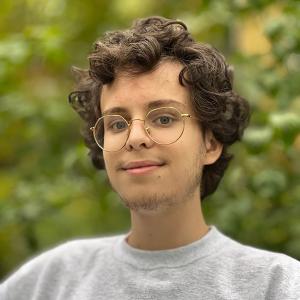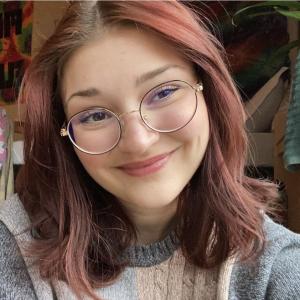Oberlin Blogs
Winter at Warner: Taking My First Dance Class
January 14, 2020
Emily Humphreys ’21
Under normal circumstances, I never would have considered taking a dance class. I know the things I’m good at, and I know dancing is not one of them. I lack rhythm, coordination, grace; really everything necessary to be a good dancer. I’m far more comfortable running experiments in a lab than I am with any sort of performance. Despite this, I spent last fall taking Introduction to Contemporary Dance, and I’m really glad I did.
I knew last fall was going to be a challenging semester well before it started. As close as I was to completing my biology major, two pretty intense classes, Cell and Molecular Biology and Principles of Organic Chemistry, stood before me, and I had decided to take them both at once. After adding a journalism class and for-credit research to the mix, my advisor and I decided it would be best for me to round out my schedule with a two-credit class. Scrolling through options online, it seemed like taking a dance class might be my best bet. As I added Intro to Contemporary to my course list, I was nervous, but also hopeful. There are many things in the world I fear, but maybe by the end of the semester dance would no longer be one of them.
I was very worried about what to wear on the first day. At first, I put on jeans, hoping we might just be looking at the syllabus. Then, I put on my ultimate frisbee clothes, but that also seemed wrong. Finally, I changed into leggings and a tee-shirt. I turned to my roommate, “This is what dancers wear, right?”
The class met in Warner Main Space, a vast room of hardwood, the ceiling high above laced with scaffolding and theater lights. I had a lot of time to look at the ceiling because one of the first things we did that day was lie down on the floor. Our instructor, Holly, led us through a series of stretches. Soft drumbeats came from the corner where a student musician accompanied our movement. Slowly, what I had thought was just a series of stretches was set to time, and, by the end of the class, I realized we were dancing.
We spent the next ten weeks rolling, leaping, bending, prancing, scurrying, leaning, and bounding. The first ten minutes of class were often dedicated to walking through the room, slowly at first, but getting faster, trying to find the spaces between people and rush through them before they closed. One day we were tasked with moving like fire, then water, then earth, then air. I normally would have been embarrassed sliding across the floor as mud or jumping up from the ground as fire, but I had come to trust my classmates. There was no room for embarrassment, we were too busy dancing.
Rolling out of bed at eight every Tuesday and Thursday was challenging, but by the end of each class, I felt alive, awake, and present in the world. I happened to have organic chemistry just after dance and concentrating through a seventy-five-minute lecture was made much more manageable by the focus and calm a morning of movement had gifted me.
A little over a month into the semester, we had two guest dancers come and teach the class. Neva and Raphael had found dance as students at Oberlin and been dancing ever since. Watching them move was entrancing. Jumping and leaning, they both seemed to have complete control over their bodies. On our first morning with them, as we were waiting for people to trickle in, Raphael invited anyone who wanted to come into the center of the space and start moving. Sitting on the mats, knees curled against my chest, I realized that I wanted to start moving. Slowly, I made my way into the center of the space and started turning and swaying. Over in the corner, a steady drumbeat started up. I held my breath and hoped beyond hope my classmates would begin to join me. None of them did. I felt my face flush deep red, I wanted to rush back to the mats and bury my face against my chest, but it was too late for that, so I stayed there, dancing until the class had gathered. Then I went back, sat down, and realized I was completely fine.
The next night Neva and Raphael performed a dance called Prime. It wasn’t at all what I expected. The show had dramatic moments, dialog, audience participation, props, costume changes, and of course, woven throughout it all, dance. I had never really thought of dance as a device to tell a story before, but Prime was a story with a hundred different meanings, and all of them were true.
Towards the end of the semester, we got the opportunity to tell stories of our own. Our final assignment was choreographing a 3- to 5-minute piece. This endeavor proved fun, but also challenging. None of the members of my group had danced before this class. There was a lot of listening to a short bit of the music, suggesting something that might be interesting, building off that first idea, trying it, realizing it didn’t work at all, and listening to the music again. Most of the members of my group were in the conservatory. I loved watching them listen to the music. I could tell they heard things in it that escaped my ear and our dance was better because of it. Slowly, bit by bit and with input from all, our piece began to come together.
Our biggest inspiration was Prime, which had centered on a sunrise. Our piece, we decided would follow a single night. The story we told focused on a girl who left home at sunset, running through the forest. In her flight, she awakened a group of forest spirits, sometimes playful, sometimes sinister, and utterly inhuman. They followed her and whisked her into the night. At first, she was afraid, but slowly she becomes more confident. Finally, just as the sun is coming up, the forest spirits place her safely back on the path. At least this is what we intended to convey. Probably about ten percent of the meaning came through to the audience in the final dance, but that’s okay, the six of us knew.
The last week of classes each group performed. Early in the morning, a crowd of supporters slowly trickled into Warner Main. My group, dressed all in black, huddled in a corner chatting nervously.
“Remember to stay perfectly still until the first daaaa da daaaa.”
“When we get in the circle, do we look to the right first or the left?”
Then, suddenly, the din quieted, and it was time to dance. It was amazing to watch the other groups' performances. One played with themes of life, death, and undeath. One was somber and full of intense political intrigue. Another incorporated acrobatic elements, and the last was a joyful tour of the seasons that ended with candy being tossed out at the crowd.
I thought I’d be nervous when it was our turn to dance, but I was remarkably calm. This is what we had rehearsed; this is what we had been working towards. The dance was far from perfect. There were times we were out of sync. My arm buckled a bit on one of the lifts. When we got in a circle, five people looked left first, and one person looked right first, but when it was all over, I felt nothing but proud. I was so happy to have shown this project we had worked so hard on to the people that had supported us and learned with us.

So, when all was said and done, did I get better at dancing this fall? The truth is I don’t really think I did. I’m still not graceful or coordinated. I still have no sense of rhythm or timing. I know some people in our class will continue on creating art in the dance department, but I probably won’t be one of them. Still, I think I learned a tremendous amount through dance. I learned to watch the world around me, and respond in concert, never competition. I learned beauty often comes from boldness in the face of uncertainty. And, perhaps most importantly, I learned to be comfortable existing in my body which, considering this is the body I will carry with me through the rest of my life, that’s far more than I could have hoped.
Similar Blog Entries

The New Bass on the Block
April 25, 2025
I decided to come to Oberlin because I wanted more music in my life. I ended up singing bass in the Obertones, Oberlin's only men's and non-binary a cappella group. I regret nothing.

Managing an Oberlin Workload
April 25, 2025
All you need to know about the transition from high school to college course work.
